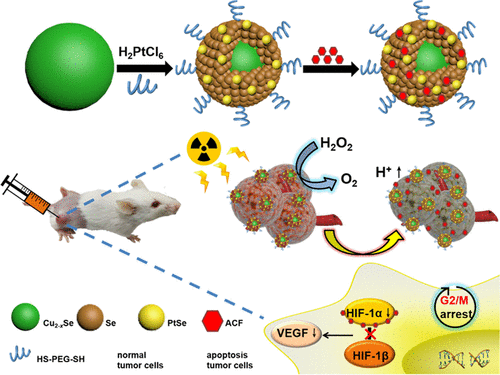当前位置:
X-MOL 学术
›
ACS Appl. Mater. Interfaces
›
论文详情
Our official English website, www.x-mol.net, welcomes your
feedback! (Note: you will need to create a separate account there.)
Overcoming Radioresistance in Tumor Therapy by Alleviating Hypoxia and Using the HIF-1 Inhibitor.
ACS Applied Materials & Interfaces ( IF 8.3 ) Pub Date : 2020-01-17 , DOI: 10.1021/acsami.9b18633 Xingguo Zhou 1 , Hanghang Liu 1 , Yanhui Zheng 1 , Yaobao Han 1 , Tingting Wang 1 , Hao Zhang 1 , Qiao Sun 1 , Zhen Li 1
ACS Applied Materials & Interfaces ( IF 8.3 ) Pub Date : 2020-01-17 , DOI: 10.1021/acsami.9b18633 Xingguo Zhou 1 , Hanghang Liu 1 , Yanhui Zheng 1 , Yaobao Han 1 , Tingting Wang 1 , Hao Zhang 1 , Qiao Sun 1 , Zhen Li 1
Affiliation

|
Radiotherapy has been extensively used to treat cancer patients because it can effectively damage most solid tumors without penetration limits. A hypoxic microenvironment in solid tumors leads to severe radioresistance and expression of hypoxic inducible factor-1 (HIF-1), which results in poor efficacy of radiotherapy alone. Herein, we report the excellent efficacy of radiotherapy achieved using a new type of yolk-shell Cu2-xSe@PtSe (CSP) nanosensitizer functionalized with the HIF-1α inhibitor acriflavine (ACF). We prepare the CSP nanosensitizer through the interfacial redox reactions between chloroplatinic acid and Cu2-xSe nanoparticles (CS) and then functionalize the nanosensitizer with ACF through their electrostatic interactions. We show that the synthesized CSP nanosensitizer can arrest the cell cycle (i.e., at the gap 2/mitosis (G2/M) phases) of tumor cells to enhance their sensitivity to X-rays and decompose endogenous H2O2 into O2 to reduce hypoxia and increase the production of reactive oxygen species, which leads to severe damage to DNA double strands and apoptosis of tumor cells. We also show that the ACF on the surface of CSP nanoparticles can effectively reduce the expression of HIF-1α. All these effects lead to a low vascular endothelial growth factor, low density of microvessels in tumor, decreased cell proliferation, and increased cell apoptosis, which synergistically and drastically enhance the efficacy of radiotherapy. This work provides insights and guidance for developing novel nanosensitizers to enhance the efficacy of radiotherapy.
中文翻译:

通过减轻缺氧和使用HIF-1抑制剂克服肿瘤治疗中的放射抗性。
放射疗法已被广泛用于治疗癌症患者,因为它可以有效地破坏大多数实体瘤而没有穿透极限。实体瘤中的低氧微环境导致严重的放射抵抗和低氧诱导因子-1(HIF-1)的表达,这导致仅放疗的疗效较差。在本文中,我们报告了使用新型HIF-1α抑制剂a啶黄(ACF)功能化的卵黄壳型Cu2-xSe @ PtSe(CSP)纳米增敏剂实现的放疗出色疗效。我们通过氯铂酸和Cu2-xSe纳米粒子(CS)之间的界面氧化还原反应制备CSP纳米增敏剂,然后通过它们的静电相互作用将纳米增敏剂与ACF功能化。我们证明了合成的CSP纳米增敏剂可以阻止细胞周期(即 在肿瘤细胞的间隙2 /有丝分裂(G2 / M)阶段),以增强其对X射线的敏感性并将内源性H2O2分解为O2以减少缺氧并增加活性氧的产生,从而严重破坏DNA双重链和肿瘤细胞的凋亡。我们还表明,CSP纳米颗粒表面的ACF可以有效降低HIF-1α的表达。所有这些作用导致血管内皮生长因子低,肿瘤中的微血管密度低,细胞增殖减少和细胞凋亡增加,从而协同和大幅度增强了放射治疗的功效。这项工作为开发新型纳米增敏剂以增强放射疗法的效力提供了见识和指导。
更新日期:2020-01-17
中文翻译:

通过减轻缺氧和使用HIF-1抑制剂克服肿瘤治疗中的放射抗性。
放射疗法已被广泛用于治疗癌症患者,因为它可以有效地破坏大多数实体瘤而没有穿透极限。实体瘤中的低氧微环境导致严重的放射抵抗和低氧诱导因子-1(HIF-1)的表达,这导致仅放疗的疗效较差。在本文中,我们报告了使用新型HIF-1α抑制剂a啶黄(ACF)功能化的卵黄壳型Cu2-xSe @ PtSe(CSP)纳米增敏剂实现的放疗出色疗效。我们通过氯铂酸和Cu2-xSe纳米粒子(CS)之间的界面氧化还原反应制备CSP纳米增敏剂,然后通过它们的静电相互作用将纳米增敏剂与ACF功能化。我们证明了合成的CSP纳米增敏剂可以阻止细胞周期(即 在肿瘤细胞的间隙2 /有丝分裂(G2 / M)阶段),以增强其对X射线的敏感性并将内源性H2O2分解为O2以减少缺氧并增加活性氧的产生,从而严重破坏DNA双重链和肿瘤细胞的凋亡。我们还表明,CSP纳米颗粒表面的ACF可以有效降低HIF-1α的表达。所有这些作用导致血管内皮生长因子低,肿瘤中的微血管密度低,细胞增殖减少和细胞凋亡增加,从而协同和大幅度增强了放射治疗的功效。这项工作为开发新型纳米增敏剂以增强放射疗法的效力提供了见识和指导。











































 京公网安备 11010802027423号
京公网安备 11010802027423号